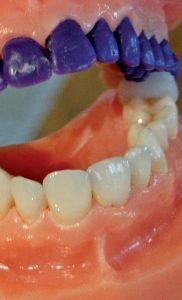Glass-ceramic dentures - German/German

The requirements for artificial teeth are high stability, even with the hardest foods, durability, natural appearance, low weight and affordability. In addition, they must not trigger any allergic reactions. Up to now, glass ceramics have been produced using the wax-fusing process, as shown here by Zahntechnik Jung, Wertheim. Glass artists also use this technique. An example of this is Isabelle Böhm's "Weeping Mary" in our studio glass cabinet at the Kleines Haus.
Scientists from Jena have now succeeded in developing a novel, extremely stable dental prosthesis made of glass ceramics. Christian Rüssel and his team from the Otto Schott Institute for Glass Chemistry at the Friedrich Schiller University of Jena use nano-technology for this. Prosthetics companies are already queuing up to buy the new dental prosthesis. In addition to dental prostheses, the glass ceramics may also be used as bone replacements in the human body.
Ceramic Glass Dentures - English

False teeth have to be very robust, able to withstand the hardest foods, durable, have a natural appearance, minimum weight and be affordable and hypoallergenic. A lost-wax casting process, as used by the Wertheim Company Zahntechnik Jung, or Jung Tooth Technology has been used for the ceramic glass dentures that have been produced up until now. Glass artists also use this technique and we have an example of it here in the museum: Isablle Böhm's "Weeping Mary," or "Weeping Mary," in the Studio Glass cabinet in the small museum building.
But scientists from Jena have now developed a new and extremely robust ceramic glass denture. Christian Rüssel and his team from the Otto Schott Institute for Glass-Chemistry at the Friedrich Schiller University use nano-technology to produce it. Prosthetics companies are queuing to get hold of it and ceramic glass is also regarded as a possible material for future human bone replacement.